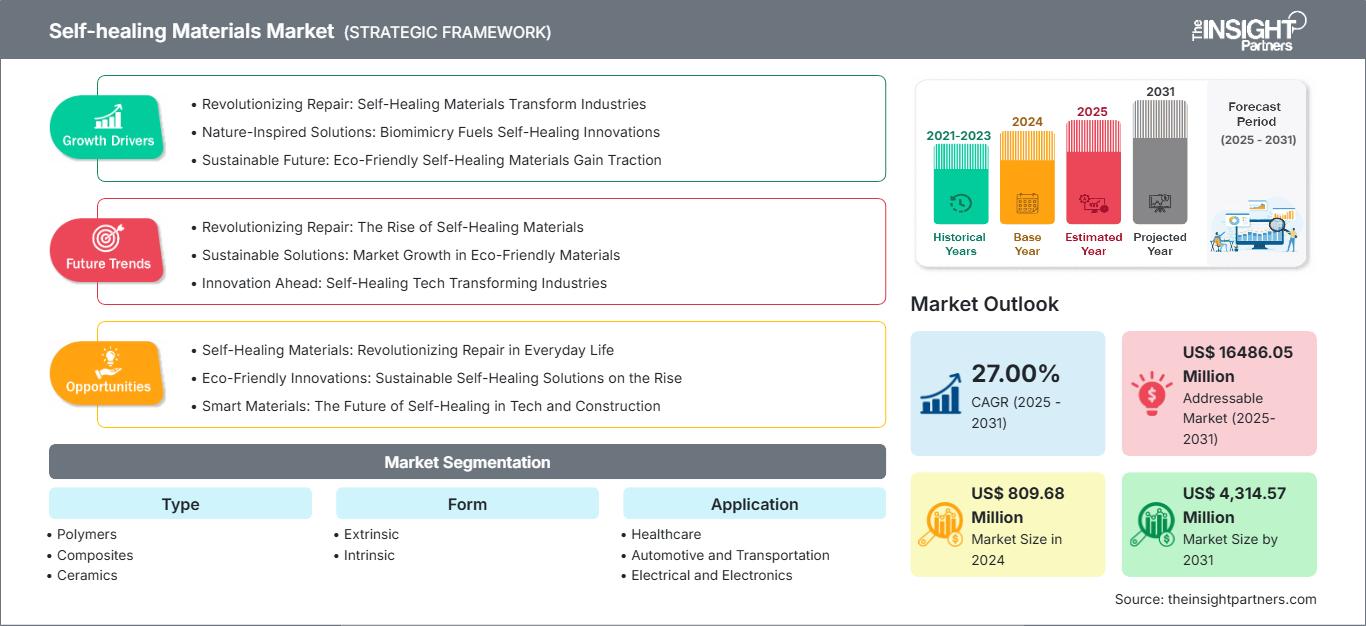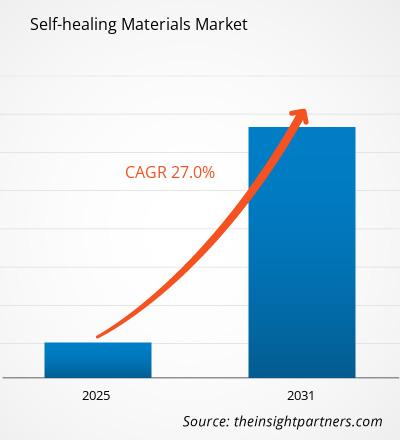Der Markt für selbstheilende Materialien wird voraussichtlich zwischen 2025 und 2031 eine durchschnittliche jährliche Wachstumsrate (CAGR) von 27,00 % verzeichnen, wobei die Marktgröße von 809,68 Millionen US-Dollar im Jahr 2024 auf 4.314,57 Millionen US-Dollar im Jahr 2031 anwachsen wird.
Der Bericht ist nach Typ (Polymere, Verbundwerkstoffe, Keramik, Beton) kategorisiert und analysiert den Markt anhand der Form (extrinsisch, intrinsisch). Er untersucht den Markt auch nach Anwendung (Gesundheitswesen, Automobil und Transport, Elektrotechnik und Elektronik, Bauwesen). Für jedes dieser Schlüsselsegmente wird eine umfassende Aufschlüsselung auf globaler, regionaler und Länderebene bereitgestellt.
Der Bericht enthält Marktgrößen und Prognosen für alle Segmente und stellt die Werte in US-Dollar dar. Er liefert außerdem wichtige Statistiken zur aktuellen Marktlage führender Akteure sowie Einblicke in aktuelle Markttrends und neue Chancen.
Zweck des Berichts
Der Bericht „Markt für selbstheilende Materialien“ von The Insight Partners beschreibt die aktuelle Situation und das zukünftige Wachstum sowie die wichtigsten treibenden Faktoren, Herausforderungen und Chancen. Dies bietet verschiedenen Geschäftspartnern Einblicke, wie zum Beispiel:
- Technologieanbieter/-hersteller: Um die sich entwickelnde Marktdynamik zu verstehen und die potenziellen Wachstumschancen zu kennen, können sie fundierte strategische Entscheidungen treffen.
- Investoren: Durchführung einer umfassenden Trendanalyse hinsichtlich der Marktwachstumsrate, der finanziellen Marktprognosen und der Chancen entlang der Wertschöpfungskette.
- Regulierungsbehörden: Sie regulieren die Richtlinien und polizeilichen Aktivitäten auf dem Markt mit dem Ziel, Missbrauch zu minimieren, das Vertrauen der Anleger zu wahren und die Integrität und Stabilität des Marktes aufrechtzuerhalten.
Marktsegmentierung für selbstheilende Materialien
Typ
- Polymere
- Verbundwerkstoffe
- Keramik
- Beton
Bilden
- Extrinsisch
- Intrinsisch
Anwendung
- Gesundheitspflege
- Automobil- und Transportwesen
- Elektrik und Elektronik
- Bauwesen
Sie erhalten kostenlos Anpassungen an jedem Bericht, einschließlich Teilen dieses Berichts oder einer Analyse auf Länderebene, eines Excel-Datenpakets sowie tolle Angebote und Rabatte für Start-ups und Universitäten.
Markt für selbstheilende Materialien: Strategische Einblicke

-
Holen Sie sich die wichtigsten Markttrends aus diesem Bericht.Dieses KOSTENLOSE Beispiel umfasst Datenanalysen, die von Markttrends bis hin zu Schätzungen und Prognosen reichen.
Wachstumstreiber für den Markt für selbstheilende Materialien
- Revolutionäre Reparatur: Selbstheilende Materialien verändern Branchen
- Von der Natur inspirierte Lösungen: Biomimikry fördert selbstheilende Innovationen
- Nachhaltige Zukunft: Umweltfreundliche selbstheilende Materialien gewinnen an Bedeutung
Zukünftige Trends auf dem Markt für selbstheilende Materialien
- Revolutionäre Reparatur: Der Aufstieg selbstheilender Materialien
- Nachhaltige Lösungen: Marktwachstum bei umweltfreundlichen Materialien
- Innovation voraus: Selbstheilende Technologie verändert Branchen
Marktchancen für selbstheilende Materialien
- Selbstheilende Materialien: Revolutionierung der Reparatur im Alltag
- Umweltfreundliche Innovationen: Nachhaltige Selbstheilungslösungen auf dem Vormarsch
- Intelligente Materialien: Die Zukunft der Selbstheilung in Technik und Bauwesen
Regionale Einblicke in den Markt für selbstheilende Materialien
Die Analysten von The Insight Partners haben die regionalen Trends und Faktoren, die den Markt für selbstheilende Materialien im Prognosezeitraum beeinflussen, ausführlich erläutert. In diesem Abschnitt werden auch die Marktsegmente und die geografische Lage für selbstheilende Materialien in Nordamerika, Europa, im asiatisch-pazifischen Raum, im Nahen Osten und Afrika sowie in Süd- und Mittelamerika erläutert.
Umfang des Marktberichts über selbstheilende Materialien
| Berichtsattribut | Details |
|---|---|
| Marktgröße im Jahr 2024 | 809,68 Millionen US-Dollar |
| Marktgröße bis 2031 | 4.314,57 Millionen US-Dollar |
| Globale CAGR (2025 – 2031) | 27,00 % |
| Historische Daten | 2021–2023 |
| Prognosezeitraum | 2025–2031 |
| Abgedeckte Segmente |
Nach Typ
|
| Abgedeckte Regionen und Länder |
Nordamerika
|
| Marktführer und wichtige Unternehmensprofile |
|
Dichte der Marktteilnehmer für selbstheilende Materialien: Verständnis ihrer Auswirkungen auf die Geschäftsdynamik
Der Markt für selbstheilende Materialien wächst rasant. Die steigende Nachfrage der Endverbraucher ist auf Faktoren wie veränderte Verbraucherpräferenzen, technologische Fortschritte und ein stärkeres Bewusstsein für die Produktvorteile zurückzuführen. Mit der steigenden Nachfrage erweitern Unternehmen ihr Angebot, entwickeln Innovationen, um den Bedürfnissen der Verbraucher gerecht zu werden, und nutzen neue Trends, was das Marktwachstum weiter ankurbelt.

- Erhalten Sie einen Überblick über die wichtigsten Akteure auf dem Markt für selbstheilende Materialien
Wichtige Verkaufsargumente
- Umfassende Abdeckung: Der Bericht deckt die Analyse von Produkten, Dienstleistungen, Typen und Endbenutzern des Marktes für selbstheilende Materialien umfassend ab und bietet eine ganzheitliche Landschaft.
- Expertenanalyse: Der Bericht basiert auf dem umfassenden Verständnis von Branchenexperten und Analysten.
- Aktuelle Informationen: Der Bericht gewährleistet Geschäftsrelevanz durch die Berichterstattung über aktuelle Informationen und Datentrends.
- Anpassungsoptionen: Dieser Bericht kann angepasst werden, um den spezifischen Kundenanforderungen gerecht zu werden und die Geschäftsstrategien optimal zu unterstützen.
Der Forschungsbericht zum Markt für selbstheilende Materialien kann daher dazu beitragen, die Branchensituation und die Wachstumsaussichten zu entschlüsseln und zu verstehen. Obwohl es einige berechtigte Bedenken geben mag, überwiegen die Vorteile dieses Berichts tendenziell die Nachteile.
- Historische Analyse (2 Jahre), Basisjahr, Prognose (7 Jahre) mit CAGR
- PEST- und SWOT-Analyse
- Marktgröße Wert/Volumen – Global, Regional, Land
- Branchen- und Wettbewerbslandschaft
- Excel-Datensatz
Aktuelle Berichte
Erfahrungsberichte
Grund zum Kauf
- Fundierte Entscheidungsfindung
- Marktdynamik verstehen
- Wettbewerbsanalyse
- Kundeneinblicke
- Marktprognosen
- Risikominimierung
- Strategische Planung
- Investitionsbegründung
- Identifizierung neuer Märkte
- Verbesserung von Marketingstrategien
- Steigerung der Betriebseffizienz
- Anpassung an regulatorische Trends






















 Kostenlose Probe anfordern für - Markt für selbstheilende Materialien
Kostenlose Probe anfordern für - Markt für selbstheilende Materialien